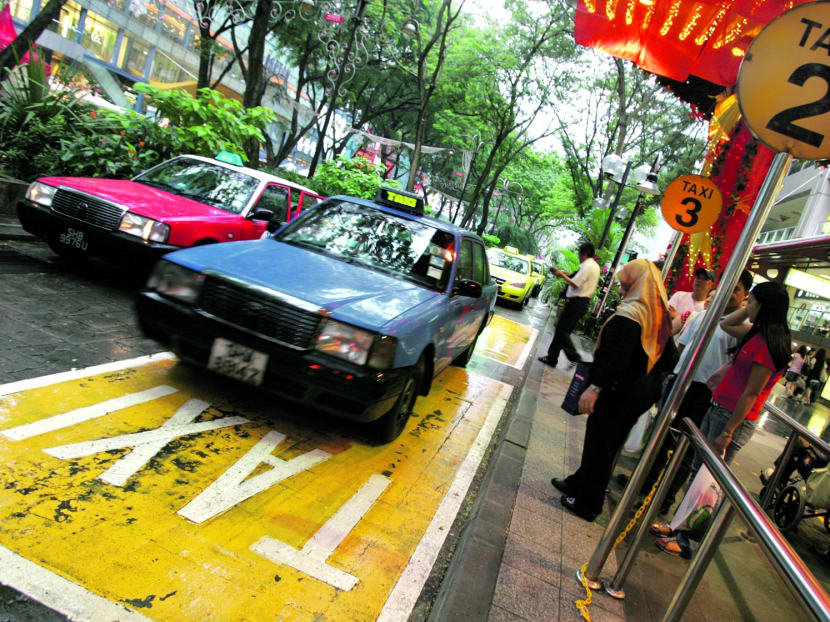3 out of 6 taxi firms fail to meet availability standards
SINGAPORE — Half of the six taxi companies here failed to meet the Land Transport Authority’s (LTA) availability standards in the first six months of the year, the LTA said yesterday.
SINGAPORE — Half of the six taxi companies here failed to meet the Land Transport Authority’s (LTA) availability standards in the first six months of the year, the LTA said yesterday.
These requirements stipulate the percentage of the operators’ fleet that should ply the roads during peak periods and the minimum daily mileage for each of their cabbies. As a penalty for not meeting the standards, Transcab, Premier and Prime Taxis — which together own about a quarter of the total number of taxis on the roads — will not be allowed to expand their fleets in the first half of next year.
Nevertheless, trotting out statistics between January and September, the LTA noted that the situation has improved. By September, only one taxi operator — Prime, the smallest player here — failed to meet both standards.
However, regular taxi commuters TODAY spoke to said they did not notice a discernible improvement in the availability of cabs over the past year. In particular, they said it was “practically impossible” to get a taxi on rainy days.
Account assistant Ong Jia Xuan, 21, who takes a cab twice a week, added that it was also hard to hail a taxi during the morning rush hour.
The LTA said it will be doing more to alleviate commuters’ woes. From July next year, it will conduct a one-year trial to monitor real-time information on passenger waiting times at five taxi stands located at Lucky Plaza, Paragon Shopping Centre, OG Building at Upper Cross Street, International Plaza and Hitachi Towers.
Using sensors, the new system will share the waiting times at these locations with taxi companies so that their taxis can be dispatched to areas with high demand.
The taxi availability framework was rolled out in January and it will be phased in over three years. For the first year, taxi companies are required to have 70 per cent of their fleet chalk up at least 250km per day and for a similar proportion to ply the roads during peak hours.
All taxi operators, except Prime Taxis, met the requirement for daily minimum mileage. And while Comfort, CityCab and SMRT were able to meet the latter requirement for the first nine months of the year, Trans-Cab managed this only from April onwards. The worst performers were Premier — which met the standard only once, in September — and Prime Taxis, which is still falling short on this count.
The LTA requires a company to pass both indicators for four months out of six months before it can be allowed to expand its fleet — up to a cap of 2 per cent on a per-annum basis — in the corresponding period the following year.
The LTA said that since the framework was introduced, more taxis have been plying the roads. In September, more than 86 per cent of Singapore’s entire taxi fleet was on the roads during peak periods, as compared to about 83 per cent in the same period last year.
The authority also noted a 6.4-per-cent increase in the number of taxis with double shifts from January to September, as compared to the same period last year. Average taxi-booking cater rate — the percentage of calls successfully matched to taxis — have also improved by 1.5 percentage points.
LTA Group Director for Public Transport Yeo Teck Guan said he would be “cautious” about saying that “everywhere in Singapore, it’s easier to get a cab”. “Sometimes it’s a traffic issue or a local issue. There might also be a spike in demand,” he said.
On anecdotal accounts by commuters that it is difficult to get a taxi on rainy days, he said: “The underlying reason is that demand actually spikes by a lot. So, under such circumstances, when there is extraordinary demand, I don’t think it is (fair) to say that taxis don’t come out, because ultimately, taxi drivers also have to earn their living.”
Noting that taxi operators and drivers have raised their game, Mr Yeo said the LTA will go ahead with implementing its second-year standards, which stipulate that both minimum mileage and peak period standards on the percentage of taxis on the roads will be increased to 80 per cent from January.
However, the standard for percentage of taxis on the roads during shoulder peak hours — between 6am and 7am, as well as between 11pm and 12am — will be adjusted downwards from the original standard of 75 per cent to 60 per cent, due to lower demand, said the LTA.
To give companies more time to adjust to the standards next year, they will only face financial penalties if they fail to meet the less stringent standards that were imposed this year. Nevertheless, they will not be allowed to expand their fleet in 2015 if they do not meet the higher standards.
Taxi operators TODAY spoke to said they will continue to work towards meeting the LTA’s standards.
Trans-Cab General Manager Jasmine Tan said a technical glitch had led to her company not being able to submit a thorough report on their performance standards in the first three months of this year. The problem has been rectified, she said. Premier has upgraded its dispatch systems, while Prime Taxi is in the midst of doing so.
The latter’s Deputy General Manager (Taxi Division) Neo Chee Yong said that meeting the standards was a challenge for a “young company” like Prime, which entered the taxi business in 2007. He added: “We find the standards to be unfairly onerous. Nonetheless, Prime Taxis has spent substantial sums to modernise our systems to comply with LTA’s requirements. ADDITIONAL REPORTING BY KENNETH CHENG









